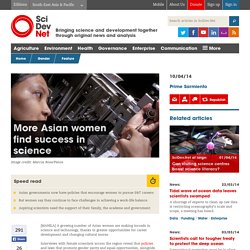

Laos education gets boost from Village Science project - SciDev.Net South-East Asia & Pacific. Many people around the world take for granted the availability of educational tools and materials online and that quality educational resources can be found with just a few clicks of the mouse.

In Laos, however, Internet access is not readily available and remains one of the missing links in achieving a more engaging learning environment that fosters creativity and exploration. In the past ten years, the country has made substantial gains in expanding access to education. The net enrolment ratio for primary education increased from 63 per cent in 1990 to about 92 per cent in school year 2008-2009. Gender differences are also decreasing. The government's vision on education highlights the need to increase female participation in all aspects of society and the economy. [1] However, substantial reforms of the educational system are still needed to bring positive social and economic changes.
Internet gap in Laos education The Village Science project References. More Asian women find success in science - SciDev.Net South-East Asia & Pacific. [MANILA] A growing number of Asian women are making inroads in science and technology, thanks to greater opportunities for career development and changing cultural mores.

Interviews with female scientists across the region reveal that policies and laws that promote gender parity and equal opportunities, alongside changing cultural perceptions on women’s roles, more supportive families and the presence of female role models, are helping women cope with the challenges they usually face when choosing a demanding career in science and the academe. For instance, in China, the Chinese Academy of Sciences has identified increasing women representation in science as an important priority. In India, the Department of Science and Technology has launched a Women Scientists’ Scheme that offers fellowships and grants to women scientists who have to take a sabbatical to raise their families. “I grew up with a lot of women as role models. Heeding the call of science Ma. Global gender disparities. 'Leftover women' in China face tough choices in looking for love.
New Report Warns 'Leftover' Chinese of Dangers. The issue of “leftover” women – those deemed by society to be past the ideal age for marriage – has continued to spark fierce debate among China’s netizens.

Recent coverage has shifted somewhat, widening in scope to include – and sometimes highlight – China’s “bachelor crisis.” Recently, Sohu, one of China’s largest online news websites, published an infographic entitled “Men and Women in Danger,” shedding more light on the predicament allegedly faced by middle-aged men and women who are unmarried. Compiling data from the 2010 national census and several recent news articles, the infographic offers an ominous outlook for China’s approximately 12 million bachelors and 6 million bachelorettes between the ages of 30 and 39. Sohu noted, “Recently, media have revealed that the ‘bare branch’ [bachelor] crisis is greater than the ‘leftover women’ issue, as the former greatly increases the risk of social instability“光棍”危机大于“剩女”问题,大大增加社会不稳定风险。.”
Microfinance turns Bihar prostitutes into businesswomen. BIHAR -- Meena Devi’s grandmother was brought from Varanasi city in Uttar Pradesh and sold in the red light area of Munger, a town on the banks of the Ganges in Bihar.

Meena’s mother also became a prostitute and so did she. “We have done this for generations so I wanted to set my daughters free from this line,” she said. In 2011, Meena, 35, was one of eight prostitutes who approached the local rural bank, Bihar Kshetriya Gramin Bank, for a loan to start a business. In an unprecedented move by the bank, the women were given a microfinance loan of Rs. 20,000 ($377) each. Four women opened a bangles shop and the four others started a tailoring service. “No government scheme or bank has touched these women,” said Mohammad Mahfooz Alam from Panah Ashram, a local NGO that educates children of prostitutes in the red light area.
Arvind Chaudhary, who oversees microfinance for the rural bank, recalls that he was passing the Panah Ashram school when these women approached him for the loan.